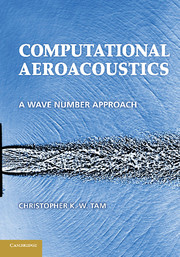Book contents
- Frontmatter
- Contents
- Preface
- 1 Finite Difference Equations
- 2 Spatial Discretization in Wave Number Space
- 3 Time Discretization
- 4 Finite Difference Scheme as Dispersive Waves
- 5 Finite Difference Solution of the Linearized Euler Equations
- 6 Radiation, Outflow, and Wall Boundary Conditions
- 7 The Short Wave Component of Finite Difference Schemes
- 8 Computation of Nonlinear Acoustic Waves
- 9 Advanced Numerical Boundary Treatments
- 10 Time-Domain Impedance Boundary Condition
- 11 Extrapolation and Interpolation
- 12 Multiscales Problems
- Chapter 13 Complex Geometry
- 14 Continuation of a Near-Field Acoustic Solution to the Far Field
- 15 Design of Computational Aeroacoustic Codes
- Appendix A Fourier and Laplace Transforms
- Appendix B The Method of Stationary Phase
- Appendix C The Method of Characteristics
- Appendix D Diffusion Equation
- Appendix E Accelerated Convergence to Steady State
- Appendix F Generation of Broadband Sound Waves with a Prescribed Spectrum by an Energy-Conserving Discretization Method
- Appendix G Sample Computer Programs
- References
- Index
15 - Design of Computational Aeroacoustic Codes
Published online by Cambridge University Press: 05 October 2012
- Frontmatter
- Contents
- Preface
- 1 Finite Difference Equations
- 2 Spatial Discretization in Wave Number Space
- 3 Time Discretization
- 4 Finite Difference Scheme as Dispersive Waves
- 5 Finite Difference Solution of the Linearized Euler Equations
- 6 Radiation, Outflow, and Wall Boundary Conditions
- 7 The Short Wave Component of Finite Difference Schemes
- 8 Computation of Nonlinear Acoustic Waves
- 9 Advanced Numerical Boundary Treatments
- 10 Time-Domain Impedance Boundary Condition
- 11 Extrapolation and Interpolation
- 12 Multiscales Problems
- Chapter 13 Complex Geometry
- 14 Continuation of a Near-Field Acoustic Solution to the Far Field
- 15 Design of Computational Aeroacoustic Codes
- Appendix A Fourier and Laplace Transforms
- Appendix B The Method of Stationary Phase
- Appendix C The Method of Characteristics
- Appendix D Diffusion Equation
- Appendix E Accelerated Convergence to Steady State
- Appendix F Generation of Broadband Sound Waves with a Prescribed Spectrum by an Energy-Conserving Discretization Method
- Appendix G Sample Computer Programs
- References
- Index
Summary
The objective of this chapter is to discuss how to design a computation code to simulate an aeroacoustic phenomenon. In previous chapters, many methods and elements of numerical computation were discussed. In this chapter, they are to be synthesized to form a computer simulation code. The basic elements/ingredients of a good simulation algorithm in computational aeroacoustics would consist of the following:
A computational model containing all essential physics of the aeroacoustic phenomenon
A properly chosen computational domain
A well-designed computational grid
A least dispersive and dissipative high-resolution time marching algorithm
A time step that ensures numerical stability and good resolution
A set of high-quality boundary conditions for both exterior and interior boundaries
A properly chosen distribution of artificial selective damping to suppress the generation and propagation of spurious short waves
A set of properly prescribed initial conditions
Basic Elements of a CAA Code
Each of the eight elements in this list affects the simulation in some way. Some exert an influence on numerical stability. Some affect the accuracy and quality of the computed solution. Others control and influence the computation time. A more detailed consideration of some of these elements in this list is provided next.
- Type
- Chapter
- Information
- Computational AeroacousticsA Wave Number Approach, pp. 329 - 394Publisher: Cambridge University PressPrint publication year: 2012
- 1
- Cited by



